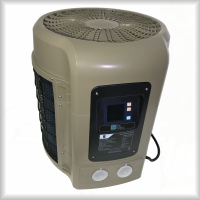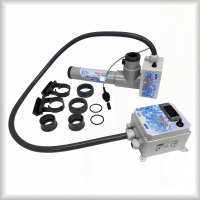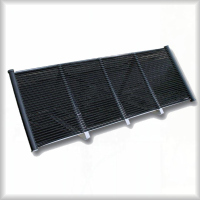
Calculating Pool Water Heating
What heating capacity to choose for a specific pool size?
One of the common questions when building a pool is: 'What heating capacity will we need for our pool?' There are several formulas based on converting various units. For our calculation, we will use the simplest method. At this point, it doesn't matter what type of heating is being considered (electric heating, heat pump, exchanger, or solar heating). First and foremost, we need to calculate the energy demand, and this is calculated the same way for all heating methods.
First, it is necessary to understand that pool heating consists of two phases:
- Heating the newly filled pool - this phase consumes the most energy because you are filling the pool with cold water that needs to be heated to a temperature suitable for swimming, known as the operational temperature of the pool. This temperature is highly subjective. Some people find 20 degrees sufficient, while others consider 30 degrees to be too cool. It is important to accurately calculate the maximum required heating capacity and subsequently the time it takes for the specific heating system to heat the water to the operational temperature. The colder the filling water and the warmer the operational water (the temperature suitable for swimming), the more powerful heating system you will need, or it will require a longer time to heat the water.
- Operational temperature maintenance of the pool water - the second phase of water heating is the operational phase, where you need to replenish the heat losses from the pool. This phase is less demanding in terms of heating capacity compared to the initial filling of the pool. The temperature losses amount to 150 - 350 W per square meter of the pool.




The amount of energy consumed for the initial heating and for maintaining the operational temperature of the pool naturally depends on other factors such as:
- Altitude
- Outdoor temperature
- Air pressure
- Wind strength
- Duration of sunlight
The influence of these factors is not so significant, and their calculation is so complex that we will not address them in our calculations.
What is important and what can you do to minimize heat loss?
- Cover the surface of the pool with a solar blanket at least.
- Insulate the construction of the pool.
- Thermally insulate underground distribution.
- Install a cover over the pool.
Any of the mentioned steps will help to some extent in preventing heat loss and reduce the energy consumption for pool heating.
Now let's move on to the actual calculation of pool heating.
Phase 1 - Heating the Newly Filled Pool
How much energy do we need to heat 1 cubic meter of water in 1 hour?
1 cubic meter of water requires 1.16 kWh of energy to heat up by 1°C in 1 hour.
Example calculation of energy consumption for a pool:
- Pool volume: 20 m³
- Filling water temperature: 15°C
- Operational water temperature (desired temperature for the pool): 25°C
- Temperature difference: 10°C
Calculation of heating power:
20 m³ x 1.16 kWh = 23.2 kWh (energy for heating up by 1°C in 1 hour)
We need to heat the water by 10°C (temperature difference = operational temperature - filling temperature)
23.2 kWh (energy for heating up by 1°C in 1 hour) x 10°C (temperature difference) = 232 kWh (total consumption for heating 20 m³)
To heat a 20 m³ pool by 10°C, you will need 232 kWh of energy.
This calculation highlights how important it is to know the temperature of the water you will be filling the pool with. Along with the volume of water, these are the two most important parameters for the calculation. If the filling water is colder or if you want to heat the pool to a higher temperature, logically you will consume more energy. You can easily measure the temperature of the filling water by letting the tap run for 5 minutes. Do you have water from a well or a stream? Measure its temperature.
Time required for the initial heating of a 20 m³ pool:
We know that we need 232 kWh of energy to heat the pool.
Now it depends on how quickly you want the pool to reach the operational temperature. This also determines the heating power of the system you choose. The calculation is simple: divide the total energy consumption by the desired heating time.
- 232 kWh (energy needed) / 24 hours (heating time) = 9.7 kW (heating power)
- 232 kWh (energy needed) / 48 hours (heating time) = 4.8 kW (heating power)
Please note that the heating time should not be so long that the heating cannot cover the operational losses of the pool, as discussed in Phase 2.
Phase 2 - Operational Temperature Regulation of the Pool
How much energy do we need to maintain the pool's temperature during operation?
The average operational energy loss from 1 square meter of an outdoor pool is 0.15 - 0.2 kW per hour. More than 90% of this loss comes from the water surface. The lower the outdoor air temperature, the higher the energy losses from the pool. You can reduce this temperature loss by covering the water surface with a solar blanket, insulating the pool body... as described above.
Calculation of energy consumption for temperature regulation of an outdoor pool during operation (using the average loss of about 0.17 kW/m²):
- Pool dimensions: 5 x 3 m
- Water surface area: 15 m²
- Thermal loss: approx. 0.17 kW/hour per 1 m²
15 m² (pool area) x 0.17 kW (thermal loss/hour/m²) = 2.55 kW / hour
The required operational heating power for temperature regulation of a 5 x 3 m pool is 2.55 kW per hour.
Here, it can be seen that the heating power required for pool operation is lower than for its initial heating.
In the next article, we will take a closer look at the options for pool heating and the differences between various types of pool heaters.
